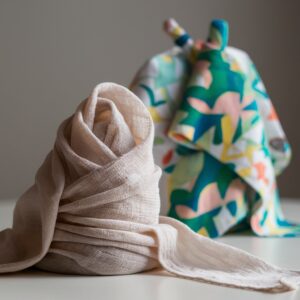What can cause confusion?
You’ve just had a baby. Everything’s new, exciting, and a little overwhelming. Muslin vs Burp Cloths: it’s common for new moms to get mixed up between muslin and burp cloths. These cloths look alike and often serve similar purposes, which can cause confusion. But knowing the differences can make caring for your little one easier and more effective. Let’s explore why this mix-up happens, how to tell these cloths apart, and simple ways to stay organized.
Why Do New Moms Confuse Muslin and Burp Cloths?
Caring for a newborn involves juggling many new tasks. When you’re learning the ropes, it’s easy to mix up these cloths. Sleep-deprived moms often make quick decisions to keep things moving. Plus, most store-bought options are packed into similar packaging, and they look alike. Add in conflicting advice from friends or online communities, and confusion is almost guaranteed. These factors make it tough to remember which cloth is which.
The Similarities Between Muslin and Burp Cloths
Soft, Absorbent Fabric Qualities
Both muslin and burp cloths are designed to be gentle on baby’s sensitive skin. They are made from fabrics that are soft and absorbent. Muslin, a lightweight cotton fabric, feels cool and breathable. Burp cloths, often made from thicker terrycloth or flannel, soak up spit-up quickly. Both keep babies comfy and avoid skin irritation.
Multi-Purpose Usage
You’ll find both cloth types used for many tasks. During the day, they catch drool, spit-up, or blowouts. Moms also use them to wipe a messy face or clean up tiny spills. A typical day might involve grabbing a muslin for swaddling or nursing, while a burp cloth catches a burp or spit-up. They’re versatile, which adds to the confusion.
Compact and Portable Design
Both are small, foldable, and lightweight. Their size makes them perfect to carry around in a diaper bag or keep nearby on a changing table. This portability is a plus but also a reason why moms might grab the wrong item without thinking.
The Key Differences That Get Overlooked
Material Composition and Texture
Muslin cloths are made from a lightweight, breathable cotton fabric. They often have a slight textured feel that gets softer after washing. Burp cloths tend to be thicker and more absorbent, made from terrycloth or flannel. They feel plush and heavy compared to muslin.
Pediatricians recommend choosing based on the task. Muslin’s breathability makes it good for wrapping or nursing cover-ups. Thick, plush burp cloths are better for absorbing spit-up.
Design and Appearance
Muslin cloths usually come with simple patterns, light colors, or plain white. Burp cloths are often more colorful, with bold patterns or branding. Visual cues like these help in distinguishing a muslin from a burp cloth quickly.
Intended Use and Functionality
Muslin is considered multi-purpose. It’s used for swaddling, nursing covers, or lightweight burp cloths. Burp cloths, on the other hand, are mainly for catching spit-up or burping. Assigning specific roles in your routine helps reduce confusion.
Durability and Maintenance
Muslin gets softer each wash, but over time, it can fray or lose some of its texture. Burp cloths, especially terrycloth, are built to withstand repeated washings and general wear. When laundry gets hectic, knowing which cloth remains durable longer helps in making the right choice.
Why Do New Moms Still Confuse These Cloths?
Lack of Experience and Overwhelm
Most new moms are adjusting to a nonstop schedule. The constant flow of new information and fatigue can make simple choices confusing. When all cloths look similar, it’s easy to grab the wrong one in a hurry.
Similar Packaging and Storage
Many cloths are stored in diaper bags or on changing tables without clear labels. Messy environments or cluttered spaces further blur the lines. Without labels or storage systems, the risk of mistake increases.
Inconsistent Terminology and Labeling
Brands don’t always use clear labels. A “muslin cloth” might be called a “multi-use cloth,” while a “burp cloth” might be a “spit-up catch-all.” This inconsistency leads to confusion, especially for first-time moms.
Advice from Others
Family members and friends often give conflicting tips based on their experiences. Some swear by muslin, while others prefer thick burp cloths. These mixed signals make it hard to settle on one right way.
How to Tell Them Apart and Use Them Correctly
Organize and Label Cloths at Home

Create designated spots for each cloth type. Use colored bins, sewing custom labels, or fold them into separate stacks. Clear areas help you remember what’s what and avoid grabbing the wrong cloth.
Educate and Reassure Yourself
Watch simple tutorial videos or read articles by trusted pediatricians. Visual guides show you what to look for and how to use each cloth properly. Knowing the purpose of each helps build confidence.
Choose High-Quality, Clearly Labeled Products
Buy muslin and burp cloths from reputable brands with obvious labeling. Look for durable fabrics that wash well and hold their shape. Quality cloths last longer and are easier to identify.
Build Routine and Consistency
Use one type of cloth for a specific task. For example, reserve muslin for nursing and swaddling, and keep thick burp cloths for spit-up. Stick to this routine and it gets easier to remember which is which.
Common Myths About Cloths
Some say all cloths are interchangeable. That’s not true. Each type has a special role. Using them correctly is better for your baby’s comfort and your sanity. Childcare experts agree that understanding each cloth’s purpose improves daily routines.
Finale: Muslin vs Burp Cloths
New moms often confuse muslin and burp cloths because they look alike and serve many similar purposes. Stress, cluttered storage, and unclear labels contribute too. But recognizing the differences in fabric, design, and use makes caregiving smoother. Organizing your cloths, labeling them, and setting routines can help avoid mix-ups. Remember, with a little effort, you can master your baby care routine more confidently. Focus on what works best for you and your baby to make these early days more manageable.
